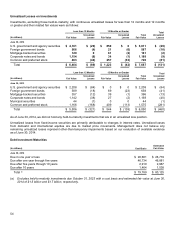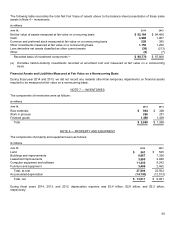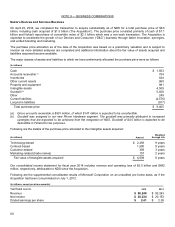Microsoft 2014 Annual Report Download - page 52
Download and view the complete annual report
Please find page 52 of the 2014 Microsoft annual report below. You can navigate through the pages in the report by either clicking on the pages listed below, or by using the keyword search tool below to find specific information within the annual report.51
Inventories
Inventories are stated at average cost, subject to the lower of cost or market. Cost includes materials, labor, and
manufacturing overhead related to the purchase and production of inventories. We regularly review inventory quantities
on hand, future purchase commitments with our suppliers, and the estimated utility of our inventory. If our review indicates
a reduction in utility below carrying value, we reduce our inventory to a new cost basis through a charge to cost of
revenue. The determination of market value and the estimated volume of demand used in the lower of cost or market
analysis require significant judgment.
Property and Equipment
Property and equipment is stated at cost and depreciated using the straight-line method over the shorter of the estimated
useful life of the asset or the lease term. The estimated useful lives of our property and equipment are generally as
follows: computer software developed or acquired for internal use, three to seven years; computer equipment, two to three
years; buildings and improvements, five to 15 years; leasehold improvements, two to 20 years; and furniture and
equipment, one to 10 years. Land is not depreciated.
Goodwill
Goodwill is tested for impairment at the reporting unit level (operating segment or one level below an operating segment)
on an annual basis (May 1 for us) and between annual tests if an event occurs or circumstances change that would more
likely than not reduce the fair value of a reporting unit below its carrying value.
Intangible Assets
All of our intangible assets are subject to amortization and are amortized using the straight-line method over their
estimated period of benefit, ranging from one to 15 years. We evaluate the recoverability of intangible assets periodically
by taking into account events or circumstances that may warrant revised estimates of useful lives or that indicate the
asset may be impaired.
Recent Accounting Guidance
Recently adopted accounting guidance
In December 2011, the Financial Accounting Standards Board (“FASB”) issued guidance enhancing disclosure
requirements about the nature of an entity’s right to offset and related arrangements associated with its financial
instruments. The new guidance requires the disclosure of the gross amounts subject to rights of set-off, amounts offset in
accordance with the accounting standards followed, and the related net exposure. In January 2013, the FASB clarified
that the scope of this guidance applies to derivatives, repurchase agreements, and securities lending arrangements that
are either offset or subject to an enforceable master netting arrangement, or similar agreements. We adopted this new
guidance beginning July 1, 2013. Adoption of this new guidance resulted only in changes to the presentation of
Note 5 – Derivatives.
In February 2013, the FASB issued guidance on disclosure requirements for items reclassified out of AOCI. This new
guidance requires entities to present (either on the face of the income statement or in the notes to financial statements)
the effects on the line items of the income statement for amounts reclassified out of AOCI. We adopted this new guidance
beginning July 1, 2013. Adoption of this new guidance resulted only in changes to the presentation of
Note 19 – Accumulated Other Comprehensive Income.
Recent accounting guidance not yet adopted
In March 2013, the FASB issued guidance on a parent’s accounting for the cumulative translation adjustment upon
derecognition of a subsidiary or group of assets within a foreign entity. This new guidance requires that the parent release
any related cumulative translation adjustment into net income only if the sale or transfer results in the complete or
substantially complete liquidation of the foreign entity in which the subsidiary or group of assets had resided. The new
guidance will be effective for us beginning July 1, 2014. We do not anticipate material impacts on our consolidated
financial statements upon adoption.
























